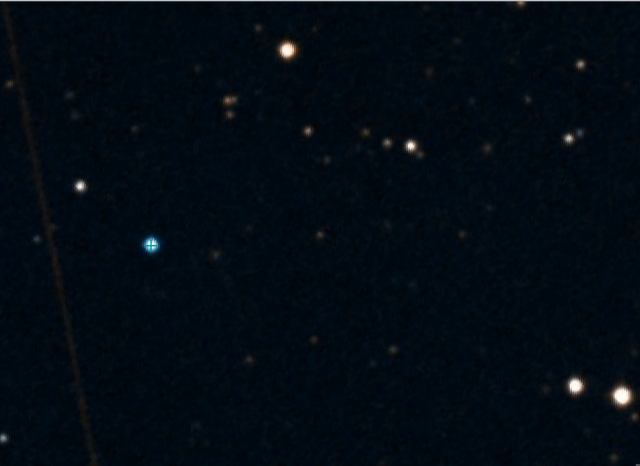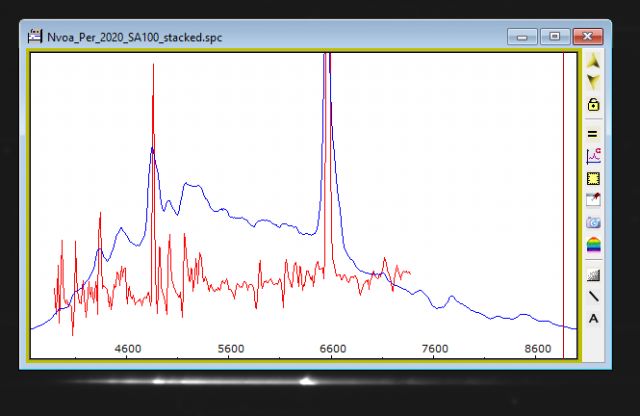Forum Replies Created
-
AuthorPosts
-
 Robin LeadbeaterParticipant
Robin LeadbeaterParticipantZTF have now called it on TNS as a type II based on a spectrum they took 5 days ago. I would not say their spectrum is over convincing though (A hint of a broad H alpha emission at the galaxy redshift, perhaps with a P Cygni profile but not much else) and running it through SNID does not come up with any high confidence hits. It shows a blue continuum suggesting not much IS extinction so it seems to be very much at the low luminosity end
Cheers
Robin
 Robin LeadbeaterParticipant
Robin LeadbeaterParticipantWell the distance to NGC2268 is probably reasonably accurate as it based on Ia supernova 1982B (which was V mag 13.5 when discovered just past maximum) so assuming this object is say mag 17.5 at maximum this gives it an absolute magnitude of -14.8 There is then 0.2 mag extinction from our own galaxy giving abs mag v mag ~ -15 which is very much at the low end but not unknown for supernovae eg
https://arxiv.org/abs/astro-ph/0112051
but if there is a lot of extinction in the host galaxy it could be higher luminosity of course.
(It could also be a foreground CV of course. We need a spectrum)
It is interesting that there has been no published professional classification yet. Maybe it is something interesting and the classification is being withheld. (Not unknown. Classifications can be submitted to TNS with an embargo)
Cheers
Robin
 Robin LeadbeaterParticipant
Robin LeadbeaterParticipantIt looks like it has levelled out, well (~5 mag) short of what a type Ia without extinction would reach
 Robin LeadbeaterParticipant
Robin LeadbeaterParticipantDoes this ring preload the taper bearing? If so it should not really be that tight (Just enough to preload the taper bearing by the right amount, hence the use of the grub screws to lock it in place.) Has it been stripped down before and retightened? (These internet strip downs never seem to talk about torque settings which I would have though are pretty critical for precision engineered parts like these)
 Robin LeadbeaterParticipant
Robin LeadbeaterParticipantThe slit is 23 microns or 3 arcsec. It normally runs in the Dec direction which is probably the best bet as the star and PSN will lie at different positions along the slit provided the seeing and guiding is good enough to split them. I could just pick up a weak spectrum of the pair with perhaps signs of a broad H alpha emission line which would indicate a type II, though there is quit a bit of that around in the galaxy background as well. No split though (and to be honest at mag 17.9 I would not stand much of a chance of getting a useable spectrum in any case)
 Robin LeadbeaterParticipant
Robin LeadbeaterParticipantThis video suggests a conventional right hand thread. (Though it also shows it to be deceptively simple to remove !)
https://www.youtube.com/watch?v=SrvkKjgjbRY
(16 min 30 sec)
 Robin LeadbeaterParticipant
Robin LeadbeaterParticipantWell done for splitting it from the nearby star. I put the spectrograph slit on it but it is so messy round there, it is going to have to outshine the star and galaxy background if I am going to have any chance.
 Robin LeadbeaterParticipant
Robin LeadbeaterParticipantSorry this is a historical observation from the Digitized Sky Survey plates
 Robin LeadbeaterParticipant
Robin LeadbeaterParticipantHave just been looking at where this field is so I can take a quick look with the spectrograph guider from time to time. Impressed by how bright (and blue) it appears in the DSS image

 Robin LeadbeaterParticipant
Robin LeadbeaterParticipant>That is why I was careful to state that the dynamic range can be improved by a factor of NxN for N-fold post-binning, and not the signal to noise ratio. Sometimes the dynamic range is particularly important, such as when trying to detect extremely low contrast objects for instance.
Indeed and this is a limitation of in camera binning where unlike post binning, you cannot see the individual pixel counts, so to be sure of not having any individual saturated pixels you have to limit the total counts in a super-pixel to the full well depth of an individual pixel.(Well I suppose one could perhaps assume a gaussian distribution of brightnesses in the star image and allow a higher maximum count per super-pixel which would bring some dynamic range benefit.)
The in camera binned exposure could be split into NxN shorter sub-exposures to match the post binned dynamic range without risking saturation but that then returns you to the same read noise contribution as for post binning. In camera binning can be advantageous though for weak signals in a dark background where the read noise contribution can be significant (in spectroscopy at low SNR for example.)
 Robin LeadbeaterParticipant
Robin LeadbeaterParticipantI think you mean oversampled ie there are more than 2 pixels per star FWHM. (Why do you consider 1.7 arcsec pixel optimum? What is your actual best seeing?)
Undersampling is to be avoided for science applications but the effect of the additional read noise on signal/noise ratio due to oversampling (this is the only disadvantage I know of) depends on the observation. Playing with Michael Richmond’s calculator for example entering actual numbers for different cameras and observing conditions will give you an idea of the significance for photometry.
http://spiff.rit.edu/richmond/signal.shtml
Note with CCD cameras (not CMOS), in camera binning (as opposed to post binning) reduces the read noise as there is only one dose per binned super- pixel, though CMOS cameras generally have lower read noise
Cheers
Robin
 Robin LeadbeaterParticipant
Robin LeadbeaterParticipantCould a short term solution be for the submitter to have the option to disable plate solving where it is obviously incorrect or otherwise inappropriate
Cheers
Robin
 Robin LeadbeaterParticipant
Robin LeadbeaterParticipantLiving near the wettest place in England, dewing is ever present hazard for me but with this specific ATIK camera model which I have been running for many years the only time I have had a dewing problem has been when water got into an SCT when it got rained on making the air inside the telescope particularly humid. The dew then was on the outside of the camera window and drying out the telescope solved the problem. If this is a reoccurring problem (eg with an open tube telescope) this is where a specific dew heater for the camera could help. The other possibility though is dewing internal to the camera, either on the inside of the camera window or on the sensor cover glass (this can actually be frost if the sensor is cooled,as here). In the ATIK cameras, this is prevented by making the chamber in front of the sensor hermetically sealed and the air kept dry by a desiccant tablet. If the dewing is on the inside it is because the air in the chamber has become wet (either over time or because the seal has failed) In this case opening the chamber in a warm dry environment, introducing dry air and recharging the desiccant as ATIK recommend will solve the problem, though the solution may be temporary if the chamber is leaky.
Cheers
Robin
 Robin LeadbeaterParticipant
Robin LeadbeaterParticipantWill already published links to specific observations still work?
Robin
 Robin LeadbeaterParticipant
Robin LeadbeaterParticipantThe ability to upload multiple images against an observing report rather than having to construct a composite image would be useful eg
https://britastro.org/node/23284
Robin
 Robin LeadbeaterParticipant
Robin LeadbeaterParticipantIt could be the desiccant tablet needs changing. This is easy on the later ATIK cameras but you have to take the back off the 314 to get to it. I have not yet had to do it but have this page bookmarked in case I do
https://forums.atik-cameras.com/index.php?topic=571.0
Cheers
Robin
8 December 2020 at 11:49 pm in reply to: Novae Cas and Per 2020 H alpha at medium resolution #583494 Robin LeadbeaterParticipant
Robin LeadbeaterParticipantYes it is real. I also see it in a Star Analyser spectrum I took a couple of days ago. It is a blend of several lines ~4500-4600A unresolved at the Star Analyser resolution Here it is overlaid on a spectrum from David Boyd in the BAA database (red)
(It looks quite intense relative to H gamma because H lines are narrow compared with the Star Analyser resolution so are reduced in height)
Cheers
Robin

 Robin LeadbeaterParticipant
Robin LeadbeaterParticipantV-I is a ratio though so should be independent of the actual flux under some scenarios eg partial obscuration by a completely opaque medium or by one which semi-transparent but absorbs equally at all wavelengths. We can therefore rule out these scenarios based on this. I agree though for scenarios where there is an additive effect eg starspots (or like your flares) the absolute magnitudes need to be considered to separate out the two components. Fortunately there is plenty of V mag data and the spectra cover the full passband so the spectra could be converted to absolute magnitude
 Robin LeadbeaterParticipant
Robin LeadbeaterParticipantThe amateur spectroscopic monitoring was very extensive and as far as I know remains untapped by professionals. It would be interesting to know how our data fits the various models.
Cheers
Robin
 Robin LeadbeaterParticipant
Robin LeadbeaterParticipantI think it is still valid though. Similar to a colour index, sort of (V-I)
Cheers
Robin
-
AuthorPosts
